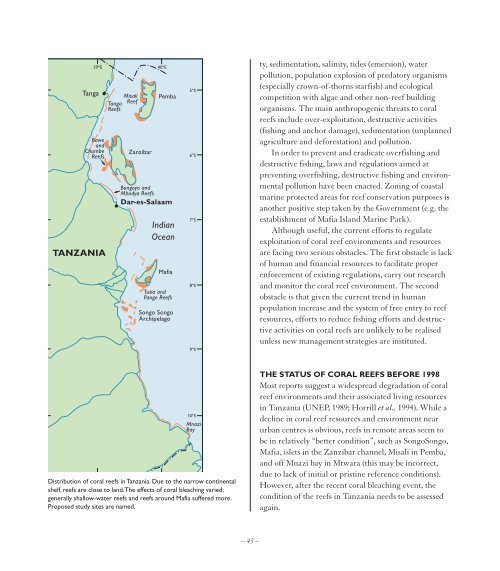Create successful ePaper yourself
Turn your PDF publications into a flip-book with our unique Google optimized e-Paper software.
Tanga<br />
TANZANIA<br />
39ºE 40ºE<br />
Bawe<br />
and<br />
Chumbe<br />
Reefs<br />
Misali<br />
Tanga Reef<br />
Reefs<br />
Zanzibar<br />
Pemba<br />
Bongoyo and<br />
Mbudya Reefs<br />
Dar-es-Salaam<br />
Indian<br />
Ocean<br />
Mafia<br />
Tutia and<br />
Pange Reefs<br />
Songo Songo<br />
Archipelago<br />
5ºS<br />
6ºS<br />
7ºS<br />
8ºS<br />
9ºS<br />
ty, sedimentation, salinity, tides (emersion), water<br />
pollution, population explosion of predatory organisms<br />
(especially crown-of-thorns starfish) and ecological<br />
competition with algae and other non-reef building<br />
organisms. The main anthropogenic threats to coral<br />
reefs include over-exploitation, destructive activities<br />
(fishing and anchor damage), sedimentation (unplanned<br />
agriculture and deforestation) and pollution.<br />
In order to prevent and eradicate overfishing and<br />
destructive fishing, laws and regulations aimed at<br />
preventing overfishing, destructive fishing and environmental<br />
pollution have been enacted. Zoning of coastal<br />
marine protected areas for reef conservation purposes is<br />
another positive step taken by the Government (e.g. the<br />
establishment of Mafia Island Marine Park).<br />
Although useful, the current efforts to regulate<br />
exploitation of coral reef environments and resources<br />
are facing two serious obstacles. The first obstacle is lack<br />
of human and financial resources to facilitate proper<br />
enforcement of existing regulations, carry out research<br />
and monitor the coral reef environment. The second<br />
obstacle is that given the current trend in human<br />
population increase and the system of free entry to reef<br />
resources, efforts to reduce fishing efforts and destructive<br />
activities on coral reefs are unlikely to be realised<br />
unless new management strategies are instituted.<br />
10ºS<br />
Mnazi<br />
Bay<br />
Distribution of coral reefs in Tanzania. Due to the narrow continental<br />
shelf, reefs are close to land. The effects of coral bleaching varied;<br />
generally shallow-water reefs and reefs around Mafia suffered more.<br />
Proposed study sites are named.<br />
THE STATUS OF CORAL REEFS BEFORE 1998<br />
Most reports suggest a widespread degradation of coral<br />
reef environments and their associated living resources<br />
in Tanzania (UNEP, 1989; Horrill et al., 1994). While a<br />
decline in coral reef resources and environment near<br />
urban centres is obvious, reefs in remote areas seem to<br />
be in relatively “better condition’’, such as SongoSongo,<br />
Mafia, islets in the Zanzibar channel, Misali in Pemba,<br />
and off Mnazi bay in Mtwara (this may be incorrect,<br />
due to lack of initial or pristine reference conditions).<br />
However, after the recent coral bleaching event, the<br />
condition of the reefs in Tanzania needs to be assessed<br />
again.<br />
– 43 –


















